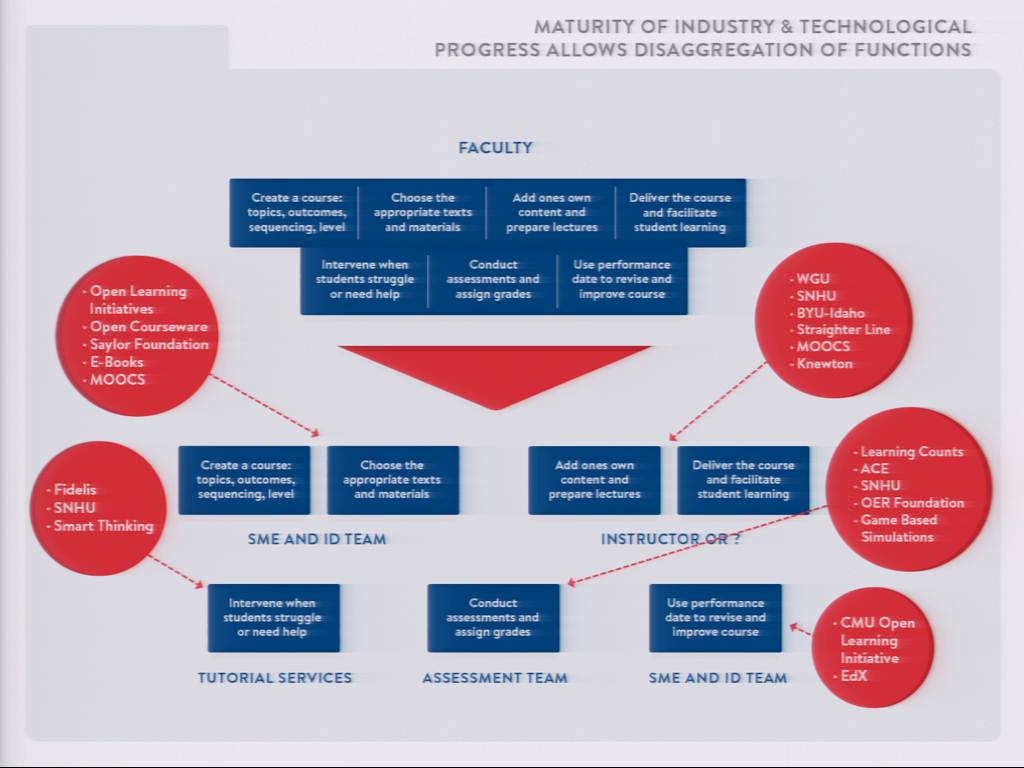Two weeks ago I attended the WCET Conference in Denver. While much smaller than EDUCAUSE and some others, I find these conferences to be great learning experiences, especially as WCET supports open dialogue between academic leaders (provosts, deans, etc), academic IT and edtech support, and industry leaders. The combination of mindsets – especially the combination of academic and technology – leads to very strategic discussions.
This year the keynote was presented by Dr. Paul LeBlanc, the president of Southern New Hampshire University, which has made quite a name for itself with the College for America (CfA) program. College for America is probably the second best-known example of competency-based education (CBE) after Western Governors University (WGU), and in fact the CfA program was the first to gain Department of Education approval using the “direct assessment” rule that completely avoids seat time. See my previous post for a primer on CBE.
While you can see the entire keynote here (using the mediasite player), I wanted to highlight four key points that help illuminate the reality of competency-based education today. As CBE becomes more hotly debated, it is useful to have real examples to evaluate. I have very roughly paraphrased and taken notes on what I heard in the keynote on these points, not as a defense or endorsement of CfA, but as a real-world early example of CBE.
1) Competency-based education is typically targeted at working adults (14:11 – 20:40)
One of the things that muddies our own internal debates and policy maker debates is that we say things about higher education as if it’s monolithic. We say that ‘competency-based education is going to ruin the experience of 18-year-olds’. Well, that’s a different higher ed than the people we serve in College for America. There are multiple types of higher ed with different missions.
The one CfA is interested in is the world of working adults – this represent the majority of college students today. Working adults need credentials that are useful in the workplace, they need low cost, they need me short completion time, and they need convenience. Education has to compete with work and family requirements.
CfA targets the bottom 10% of wage earners in large companies – these are the people not earning sustainable wages. They need stability and advancement opportunities.
CfA has two primary customers – the students and the employers who want to develop their people. In fact, CfA does not have a retail offering, and they directly work with employers to help employees get their degrees.
2) Competency-based education can require the unbundling of instruction (25:56 – 32:14)
One of the goals of CfA is to use technology to rethink its own business processes, which leads to disaggregation or unbundling. Higher ed does have experience with unbundling with food services, marketing services, but typically higher ed has resisted unbundling the core of what we do – instruction. Traditional faculty can fiercely hold on to these functions. This unbundling causes you to rethink the processes around course design, instruction, advising, and assessment, and there are a growing number of sources for these services (see slide below).
The most important change is to rethink the credit hour, which is the Higgs-Boson – the god particle – of higher ed. Amy Laitinen has a great article explaining the history of the credit hour. It’s great at telling you how long a student has sat down, but not very good at telling you what the student knows. We know that employers trust higher ed less and less. This leads to the core concept of competency-based education – focus on competencies rather than seat times. Jobs for students are not the only goal for higher education, but employers don’t think we do a very good job.
credit: Paul LeBlanc slides at WCET13
3) Competency-based assessment does not equal testing (41:14 – 45:05)
Competencies are can-do statements, they’re measurable, they’re observable, and they are harder for some disciplines than for others.
CfA doesn’t do tests – they instead rely on project-based learning. Competencies never exist in isolation, as they end up in workplace situations. When students select which cluster of competencies to work on, they select an appropriate role to take and work through the projects.
The projects lead to filled-out rubrics that are evaluated by trained faculty, typically with a 48-hour turn-around time.
4) Competency-based education often requires custom IT systems such as the LMS (45:08 – 46:19)
Most higher ed IT systems have been designed with the traditional credit hour in mind, with defined start and end dates. CfA started using Blackboard but abandoned that effort right away. They then went to Canvas, but Canvas is still very credit-hour based. This is not a knock on those LMSs, since they were built to solve a different problem.
In the end, CfA developed their own LMS based on the Salesforce.com platform. The first iteration of the platform was a kludgy mashup, and they had to do a lot of work to simplify the user interface.
Full disclosure: Western Governors University has been a client of MindWires Consulting.
